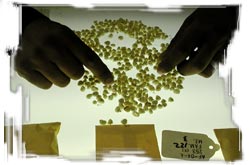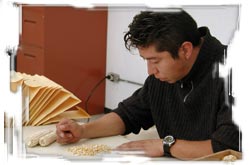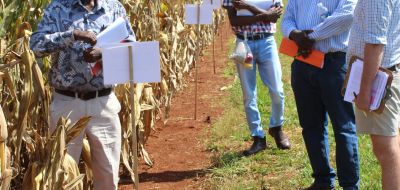Conservation by the numbers: Reducing genetic drift in crop gene bank collections
CIMMYT E-News, vol 3 no. 1, January 2006
 CIMMYT’s biometrics team receives special recognition for advancing the science behind crop genetic resource conservation.
The nightmare of a gene bank curator: You have a collection of 25,000 precious, unique samples of maize seed; one of the world’s most extensive. You store it carefully, keep it cold and dry, but—little by little over the years—the seed dies! Eventually you’re left with so many packets of useless kernels, and the precious genetic diversity they once embodied is lost to humanity forever.
To keep this very bad dream from becoming a reality, Suketoshi Taba, head of maize genetic resources at CIMMYT, and his team constantly monitor the germination capacity of collections. When it drops below 80-85%, they take viable seed from the endangered accession (the term for individual, registered samples in the bank), sow it under controlled conditions, and harvest enough from progeny to replenish the accession. Known as “regeneration,” the process sounds simple, but in fact must be done painstakingly to capture a faithful snapshot—rather than a faded copy—of the genetic diversity from the original accession.
The Crop Science Society of America recently bestowed the honor of “2004 Outstanding Paper on Plant Genetic Resources” on an article by CIMMYT biometricians that provides models for proper handling of repeated cycles of regeneration. Their work, which was funded by the Australian Grains Research and Development Corporation (GRDC), is particularly relevant for outcrossing, genetically diverse crops like maize, legumes, or sorghum, to name just a few.
CIMMYT’s biometrics team receives special recognition for advancing the science behind crop genetic resource conservation.
The nightmare of a gene bank curator: You have a collection of 25,000 precious, unique samples of maize seed; one of the world’s most extensive. You store it carefully, keep it cold and dry, but—little by little over the years—the seed dies! Eventually you’re left with so many packets of useless kernels, and the precious genetic diversity they once embodied is lost to humanity forever.
To keep this very bad dream from becoming a reality, Suketoshi Taba, head of maize genetic resources at CIMMYT, and his team constantly monitor the germination capacity of collections. When it drops below 80-85%, they take viable seed from the endangered accession (the term for individual, registered samples in the bank), sow it under controlled conditions, and harvest enough from progeny to replenish the accession. Known as “regeneration,” the process sounds simple, but in fact must be done painstakingly to capture a faithful snapshot—rather than a faded copy—of the genetic diversity from the original accession.
The Crop Science Society of America recently bestowed the honor of “2004 Outstanding Paper on Plant Genetic Resources” on an article by CIMMYT biometricians that provides models for proper handling of repeated cycles of regeneration. Their work, which was funded by the Australian Grains Research and Development Corporation (GRDC), is particularly relevant for outcrossing, genetically diverse crops like maize, legumes, or sorghum, to name just a few.
 “For maize regeneration, we use artificial pollination, to avoid out-crossing with pollen from other maize fields,” says Taba. “But even the individuals in a maize population or accession are genetically diverse. How can we decide on the best way to pollinate the plants, or how many ears we need to harvest, or how many and which seeds to choose from each ear?” According to Taba, the danger is ending up with a sample that differs from the genetic make-up of the original. And with each successive cycle of regeneration, you can drift further and further.
Building on a strong body of work in this area by CIMMYT biometricians since the 1980s, the award-winning paper refines and expands the statistical model and provides reliable computer simulations. “Among other things, the simulation model shows exactly how many alleles are likely to be lost through various sampling and regeneration strategies,” says Jiankang Wang, CIMMYT biometrician who is first author of the study. “It describes how different strategies can affect the conservation of alleles and gives gene bank curators options that can be tailored for specific types of accessions.”
Jiankang Wang says he and his co-author, CIMMYT biometrician José Crossa, are now working with Taba to apply the paper’s model in managing CIMMYT’s maize gene bank collection. “Many other gene banks will find this approach useful,” says Crossa, explaining why their study received the award. “For example, we collaborate closely with the National Center for Genetic Resources Preservation in Fort Collins, Colorado, in the USA. They can apply the same principles in their regeneration work.”
Jiankang Wang was excited by the recognition and the fact that peers might find his work useful. “In middle school, teachers saw I had talent and told me to specialize in mathematics, but at the university I discovered that I was most interested in the practical applications of mathematics,” says Jiankang Wang. “Using science to help preserve the world’s crop genetic resources is a great satisfaction.”
For more information contact Jiankang Wang ( j.k.wang@cgiar.org)
“For maize regeneration, we use artificial pollination, to avoid out-crossing with pollen from other maize fields,” says Taba. “But even the individuals in a maize population or accession are genetically diverse. How can we decide on the best way to pollinate the plants, or how many ears we need to harvest, or how many and which seeds to choose from each ear?” According to Taba, the danger is ending up with a sample that differs from the genetic make-up of the original. And with each successive cycle of regeneration, you can drift further and further.
Building on a strong body of work in this area by CIMMYT biometricians since the 1980s, the award-winning paper refines and expands the statistical model and provides reliable computer simulations. “Among other things, the simulation model shows exactly how many alleles are likely to be lost through various sampling and regeneration strategies,” says Jiankang Wang, CIMMYT biometrician who is first author of the study. “It describes how different strategies can affect the conservation of alleles and gives gene bank curators options that can be tailored for specific types of accessions.”
Jiankang Wang says he and his co-author, CIMMYT biometrician José Crossa, are now working with Taba to apply the paper’s model in managing CIMMYT’s maize gene bank collection. “Many other gene banks will find this approach useful,” says Crossa, explaining why their study received the award. “For example, we collaborate closely with the National Center for Genetic Resources Preservation in Fort Collins, Colorado, in the USA. They can apply the same principles in their regeneration work.”
Jiankang Wang was excited by the recognition and the fact that peers might find his work useful. “In middle school, teachers saw I had talent and told me to specialize in mathematics, but at the university I discovered that I was most interested in the practical applications of mathematics,” says Jiankang Wang. “Using science to help preserve the world’s crop genetic resources is a great satisfaction.”
For more information contact Jiankang Wang ( j.k.wang@cgiar.org)CIMMYT E-News, vol 3 no. 1, January 2006
 CIMMYT’s biometrics team receives special recognition for advancing the science behind crop genetic resource conservation.
CIMMYT’s biometrics team receives special recognition for advancing the science behind crop genetic resource conservation.
The nightmare of a gene bank curator: You have a collection of 25,000 precious, unique samples of maize seed; one of the world’s most extensive. You store it carefully, keep it cold and dry, but—little by little over the years—the seed dies! Eventually you’re left with so many packets of useless kernels, and the precious genetic diversity they once embodied is lost to humanity forever.
To keep this very bad dream from becoming a reality, Suketoshi Taba, head of maize genetic resources at CIMMYT, and his team constantly monitor the germination capacity of collections. When it drops below 80-85%, they take viable seed from the endangered accession (the term for individual, registered samples in the bank), sow it under controlled conditions, and harvest enough from progeny to replenish the accession. Known as “regeneration,” the process sounds simple, but in fact must be done painstakingly to capture a faithful snapshot—rather than a faded copy—of the genetic diversity from the original accession.
The Crop Science Society of America recently bestowed the honor of “2004 Outstanding Paper on Plant Genetic Resources” on an article by CIMMYT biometricians that provides models for proper handling of repeated cycles of regeneration. Their work, which was funded by the Australian Grains Research and Development Corporation (GRDC), is particularly relevant for outcrossing, genetically diverse crops like maize, legumes, or sorghum, to name just a few.

“For maize regeneration, we use artificial pollination, to avoid out-crossing with pollen from other maize fields,” says Taba. “But even the individuals in a maize population or accession are genetically diverse. How can we decide on the best way to pollinate the plants, or how many ears we need to harvest, or how many and which seeds to choose from each ear?” According to Taba, the danger is ending up with a sample that differs from the genetic make-up of the original. And with each successive cycle of regeneration, you can drift further and further.
Building on a strong body of work in this area by CIMMYT biometricians since the 1980s, the award-winning paper refines and expands the statistical model and provides reliable computer simulations. “Among other things, the simulation model shows exactly how many alleles are likely to be lost through various sampling and regeneration strategies,” says Jiankang Wang, CIMMYT biometrician who is first author of the study. “It describes how different strategies can affect the conservation of alleles and gives gene bank curators options that can be tailored for specific types of accessions.”
Jiankang Wang says he and his co-author, CIMMYT biometrician José Crossa, are now working with Taba to apply the paper’s model in managing CIMMYT’s maize gene bank collection. “Many other gene banks will find this approach useful,” says Crossa, explaining why their study received the award. “For example, we collaborate closely with the National Center for Genetic Resources Preservation in Fort Collins, Colorado, in the USA. They can apply the same principles in their regeneration work.”
Jiankang Wang was excited by the recognition and the fact that peers might find his work useful. “In middle school, teachers saw I had talent and told me to specialize in mathematics, but at the university I discovered that I was most interested in the practical applications of mathematics,” says Jiankang Wang. “Using science to help preserve the world’s crop genetic resources is a great satisfaction.”
For more information contact Jiankang Wang ( j.k.wang@cgiar.org)
